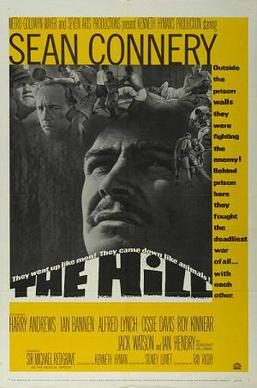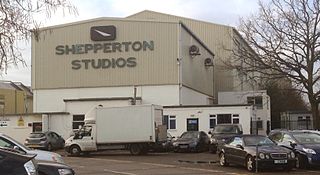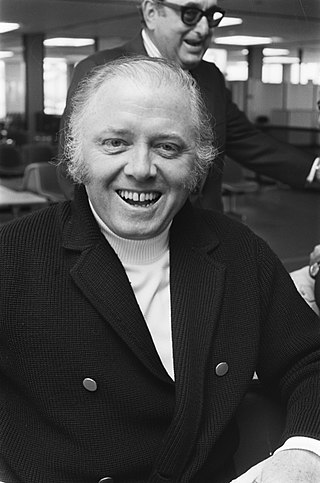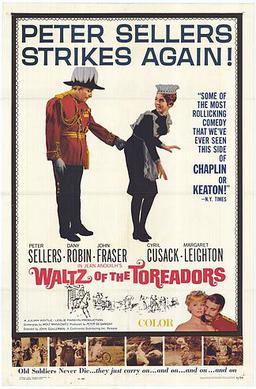
John Edward Boulting and Roy Alfred Clarence Boulting, known collectively as the Boulting brothers, were English filmmakers and identical twins who became known for their series of satirical comedies in the 1950s and 1960s. They produced many of their films through their own production company, Charter Film Productions, which they founded in 1937.

Peter Sellers was an English actor and comedian. He first came to prominence performing in the BBC Radio comedy series The Goon Show. Sellers featured on a number of hit comic songs, and became known to a worldwide audience through his many film roles, among them Chief Inspector Clouseau in The Pink Panther series.

Maria de Lourdes Villiers Farrow is an American actress. She first gained notice for her role as Allison MacKenzie in the television soap opera Peyton Place and gained further recognition for her subsequent short-lived marriage to Frank Sinatra. An early film role, as Rosemary in Roman Polanski's Rosemary's Baby (1968), saw her nominated for a BAFTA Award and a Golden Globe Award for Best Actress. She went on to appear in several films throughout the 1970s, such as Follow Me! (1972), The Great Gatsby (1974), and Death on the Nile (1978). Her younger sister is Prudence Farrow.
Sergeant major is a senior non-commissioned rank or appointment in many militaries around the world.

Britt Ekland is a Swedish actress, model, and singer. She appeared in numerous films in her heyday throughout the 1960s and 1970s, including roles in The Double Man (1967), The Night They Raided Minsky's (1968), Machine Gun McCain (1969), Stiletto (1969), and the British crime film Get Carter (1971), which established her as a sex symbol. She also starred in several horror films, including The Wicker Man (1973), and appeared as a Bond girl in The Man with the Golden Gun (1974).

John Dudley Leyton is an English actor and singer.

I'm All Right Jack is a 1959 British comedy film directed and produced by John and Roy Boulting from a script by Frank Harvey, John Boulting and Alan Hackney based on the 1958 novel Private Life by Alan Hackney.

Private's Progress is a 1956 British comedy film directed by John Boulting and starring Ian Carmichael, Peter Jones, William Hartnell and Terry-Thomas. The script was by John Boulting and Frank Harvey based on the novel of the same name by Alan Hackney.

The Hill is a 1965 British prison drama war film directed by Sidney Lumet, set in an army prison in North Africa during the Second World War. It stars Sean Connery, Harry Andrews, Ian Bannen, Ossie Davis, Ian Hendry, Alfred Lynch, Roy Kinnear and Michael Redgrave.

Death on the Nile is a 1978 British mystery film based on Agatha Christie's 1937 novel of the same name, directed by John Guillermin and adapted by Anthony Shaffer. The film features the Belgian detective Hercule Poirot, played by Peter Ustinov for the first time, plus an all-star supporting cast that includes Maggie Smith, Angela Lansbury, Bette Davis, Mia Farrow, Jane Birkin, David Niven, George Kennedy, and Jack Warden. The film is a follow-up to the 1974 film Murder on the Orient Express.

Only Two Can Play is a 1962 British comedy film directed by Sidney Gilliat starring Peter Sellers, Mai Zetterling and Virginia Maskell. The screenplay was by Bryan Forbes, based on the 1955 novel That Uncertain Feeling by Kingsley Amis.
William Modisane, better known as Bloke Modisane, was a South African writer, actor and journalist.

Percy Herbert was an English actor. He worked predominantly from the 1950s into the 1970s and became one of the most recognisable faces in post-war British cinema.

Never Let Go, also known as Moment of Truth, is a 1960 British thriller film directed by John Guillermin and starring Richard Todd, Peter Sellers and Elizabeth Sellars. It concerns a man's attempt to recover his stolen car. Sellers plays a London villain, in one of his rare serious roles.

Shepperton Studios is a film studio located in Shepperton, Surrey, England, with a history dating back to 1931. It is now part of the Pinewood Studios Group. During its early existence, the studio was branded as Sound City.

Richard Samuel Attenborough, Baron Attenborough, was an English actor, film director, and producer.

John Guillermin was a French-British film director, writer and producer who was most active in big-budget, action-adventure films throughout his lengthy career.
Max Peter Benedict was an Austrian born, British film editor.

Waltz of the Toreadors is a 1962 film directed by John Guillermin and starring Peter Sellers and Dany Robin. It was based on the play of the same name by Jean Anouilh with the location changed from France to England. It was nominated for a BAFTA Award for Best British Screenplay, in 1963.

Mia Farrow is an American actress whose career has spanned six decades. The daughter of actress Maureen O'Sullivan and director John Farrow, she had an uncredited appearance in John Paul Jones (1959) before making her feature debut in Guns at Batasi (1964), for which she earned a Golden Globe for New Star of the Year. From 1964 to 1966, she portrayed Allison MacKenzie on the dramatic television series Peyton Place.

















